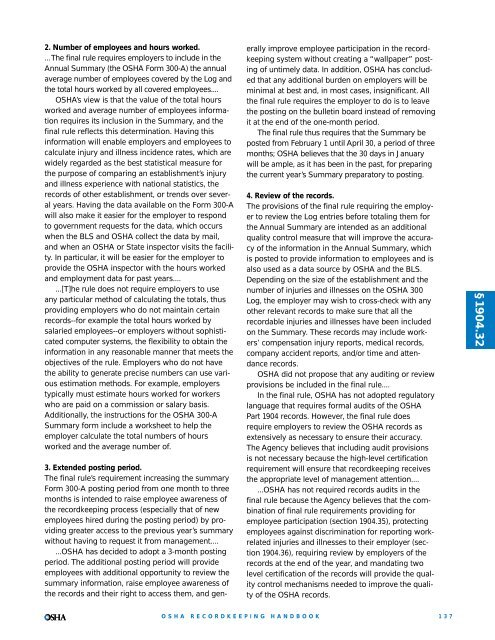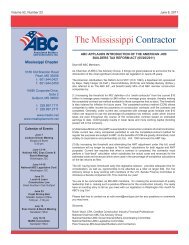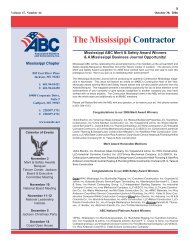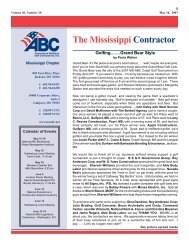§1904.32The company executive certification is intendedto ensure that a high ranking company official withresponsibility for the recordkeeping activity and theauthority to ensure that the recordkeeping function isperformed appropriately has examined the recordsand has a reasonable belief, based on his or herknowledge of that process, that the records are accurateand complete.The final rule does not specify how employers areto evaluate their recordkeeping systems to ensuretheir accuracy and completeness or what steps anemployer must follow to certify the accuracy andcompleteness of the Log and Summary with confidence.However, to be able to certify that one has areasonable belief that the records are complete andaccurate would suggest, at a minimum, that the certifieris familiar with <strong>OSHA</strong>’s recordkeeping requirements,and the company’s recordkeeping practicesand policies, has read the Log and Summary, andhas obtained assurance from the staff responsible formaintaining the records (if the certifier does not personallykeep the records) that all of <strong>OSHA</strong>’s requirementshave been met and all practices and policiesfollowed. In most if not all cases, the certifier will befamiliar with the details of some of the injuries andillnesses that have occurred at the establishment andwill therefore be able to spot check the <strong>OSHA</strong> 300Log to see if those cases have been entered correctly.In many cases, especially in small to medium establishments,the certifier will be aware of all of theinjuries and illnesses that have been reported at theestablishment and will thus be able to inspect theforms to make sure all of the cases that should havebeen entered have in fact been recorded.The certification required by the final rule may bemade by signing and dating the certification sectionof the <strong>OSHA</strong> 300-A form, which replaces the summaryportion of the former <strong>OSHA</strong> 200 form, or by signingand dating a separate certification statement andappending it to the <strong>OSHA</strong> Form 300-A. A separatecertification statement must contain the identicalpenalty warnings and employee access informationas found on the <strong>OSHA</strong> Form 300-A. A separate statementmay be needed when the certifier works atanother location and the certification is mailed orfaxed to the location where the Summary is posted.......The criminal penalties referred to in paragraph1904.9(a) of the former rule are authorized by section17(g) of the OSH Act and do not need to be repeatedin the final rule to be enforced. Similarly, the administrativecitations and penalties referred to in paragraph1904.9(b) of the former rule are authorized bysections 9 and 17 of the OSH Act. The warning statementon the final <strong>OSHA</strong> 300-A form or its equivalentshould be sufficient to remind those who certify theforms of their legal obligations under the Act....<strong>OSHA</strong> has not adopted a dual certification requirementbecause one certification should be enough tomake sure that the records are accurate. In addition,a dual certification requirement would increase thecomplexity and burdens of the final rule, without significantlyadding incentives for employers to keepbetter records....Although <strong>OSHA</strong> believes that the final rule hasmany features that will enhance the accuracy andcompleteness of reporting, the Agency has includeda company executive level of certification in the finalrule. <strong>OSHA</strong> believes that company executive certificationwill raise employer awareness of the importanceof the <strong>OSHA</strong> records, improve their accuracy andcompleteness (and thus utility), and decrease anyunderreporting incentive.The final rule therefore requires a higher levelcompany official to certify to their accuracy and completeness.Thus the final rule reflects <strong>OSHA</strong>’s agreementwith those commenters who stated that theLog and Summary must be actively overseen byhigher level management and that certification bysuch an official would make management’s responsibilityfor the accuracy and completeness of the systemclear.......In the final rule, the person who must performthe certification must be a company executive. <strong>OSHA</strong>does not believe that an industrial hygienist or a safetyofficer is likely to have sufficient authority toensure the integrity of a company’s recordkeepingprocess. Therefore, the final rule requires that thecertification be provided by an owner of a sole proprietorshipor partnership, an officer of the corporation,the highest-ranking official at the establishment,or that person’s supervisor.......<strong>OSHA</strong> has added that the certification requiredby the final rule must be based on the official’s “reasonablebelief” that the Log and Summary are accurateand complete. Certification thus means that thecertifying official has a general understanding of the<strong>OSHA</strong> recordkeeping requirements, is familiar withthe company’s recordkeeping progess, and knowsthat the company has effective recordkeeping proceduresand uses those procedures to produce accurateand complete records. The precise meaning of“reasonable belief” will be determined on a case-bycasebasis because circumstances vary from establishmentto establishment and decisions about therecordability of individual cases may differ, dependingupon case-specific details.136<strong>OSHA</strong> RECORDKEEPINGHANDBOOK
2. Number of employees and hours worked....The final rule requires employers to include in theAnnual Summary (the <strong>OSHA</strong> Form 300-A) the annualaverage number of employees covered by the Log andthe total hours worked by all covered employees....<strong>OSHA</strong>’s view is that the value of the total hoursworked and average number of employees informationrequires its inclusion in the Summary, and thefinal rule reflects this determination. Having thisinformation will enable employers and employees tocalculate injury and illness incidence rates, which arewidely regarded as the best statistical measure forthe purpose of comparing an establishment’s injuryand illness experience with national statistics, therecords of other establishment, or trends over severalyears. Having the data available on the Form 300-Awill also make it easier for the employer to respondto government requests for the data, which occurswhen the BLS and <strong>OSHA</strong> collect the data by mail,and when an <strong>OSHA</strong> or State inspector visits the facility.In particular, it will be easier for the employer toprovide the <strong>OSHA</strong> inspector with the hours workedand employment data for past years.......[T]he rule does not require employers to useany particular method of calculating the totals, thusproviding employers who do not maintain certainrecords--for example the total hours worked bysalaried employees--or employers without sophisticatedcomputer systems, the flexibility to obtain theinformation in any reasonable manner that meets theobjectives of the rule. Employers who do not havethe ability to generate precise numbers can use variousestimation methods. For example, employerstypically must estimate hours worked for workerswho are paid on a commission or salary basis.Additionally, the instructions for the <strong>OSHA</strong> 300-ASummary form include a worksheet to help theemployer calculate the total numbers of hoursworked and the average number of.3. Extended posting period.The final rule’s requirement increasing the summaryForm 300-A posting period from one month to threemonths is intended to raise employee awareness ofthe recordkeeping process (especially that of newemployees hired during the posting period) by providinggreater access to the previous year’s summarywithout having to request it from management.......<strong>OSHA</strong> has decided to adopt a 3-month postingperiod. The additional posting period will provideemployees with additional opportunity to review thesummary information, raise employee awareness ofthe records and their right to access them, and generallyimprove employee participation in the recordkeepingsystem without creating a “wallpaper” postingof untimely data. In addition, <strong>OSHA</strong> has concludedthat any additional burden on employers will beminimal at best and, in most cases, insignificant. Allthe final rule requires the employer to do is to leavethe posting on the bulletin board instead of removingit at the end of the one-month period.The final rule thus requires that the Summary beposted from February 1 until April 30, a period of threemonths; <strong>OSHA</strong> believes that the 30 days in Januarywill be ample, as it has been in the past, for preparingthe current year’s Summary preparatory to posting.4. Review of the records.The provisions of the final rule requiring the employerto review the Log entries before totaling them forthe Annual Summary are intended as an additionalquality control measure that will improve the accuracyof the information in the Annual Summary, whichis posted to provide information to employees and isalso used as a data source by <strong>OSHA</strong> and the BLS.Depending on the size of the establishment and thenumber of injuries and illnesses on the <strong>OSHA</strong> 300Log, the employer may wish to cross-check with anyother relevant records to make sure that all therecordable injuries and illnesses have been includedon the Summary. These records may include workers’compensation injury reports, medical records,company accident reports, and/or time and attendancerecords.<strong>OSHA</strong> did not propose that any auditing or reviewprovisions be included in the final rule....In the final rule, <strong>OSHA</strong> has not adopted regulatorylanguage that requires formal audits of the <strong>OSHA</strong>Part 1904 records. However, the final rule doesrequire employers to review the <strong>OSHA</strong> records asextensively as necessary to ensure their accuracy.The Agency believes that including audit provisionsis not necessary because the high-level certificationrequirement will ensure that recordkeeping receivesthe appropriate level of management attention.......<strong>OSHA</strong> has not required records audits in thefinal rule because the Agency believes that the combinationof final rule requirements providing foremployee participation (section 1904.35), protectingemployees against discrimination for reporting workrelatedinjuries and illnesses to their employer (section1904.36), requiring review by employers of therecords at the end of the year, and mandating twolevel certification of the records will provide the qualitycontrol mechanisms needed to improve the qualityof the <strong>OSHA</strong> records.§1904.32<strong>OSHA</strong> RECORDKEEPINGHANDBOOK137
- Page 1 and 2:
www.osha.govOSHARecordkeepingHandbo
- Page 3 and 4:
OSHARecordkeeping HandbookThe Regul
- Page 5 and 6:
ContentsRecordkeeping HandbookRoadm
- Page 7 and 8:
Section 1904.40Providing records to
- Page 9 and 10:
Section 1904.0Purpose(66 FR 6122, J
- Page 11 and 12:
Section 1904.1Partial exemption for
- Page 13 and 14:
Section 1904.2Partial exemption for
- Page 15 and 16:
employees, to OSHA within 8 hours (
- Page 17 and 18:
Partial Exemptions for Employers Un
- Page 19 and 20:
Section 1904.4Recording criteria(66
- Page 21 and 22:
Section 1904.5Determination of work
- Page 23 and 24:
(b)(7) How do I decide if a case is
- Page 25 and 26:
well, including providing informati
- Page 27 and 28:
This exception, which responds to i
- Page 29 and 30:
or she is in the work environment a
- Page 31 and 32:
have occurred but for the occupatio
- Page 33 and 34:
considered work-related. If an empl
- Page 35 and 36:
Question 5-12. Is work-related stre
- Page 37 and 38:
• The doctor described the illnes
- Page 39 and 40:
Scenario 7:• A site hired numerou
- Page 41 and 42:
Letter of interpretation related to
- Page 43 and 44:
These principles should be applied
- Page 45 and 46:
The problem with the response is tw
- Page 47 and 48:
Section 1904.6Determination of new
- Page 49 and 50:
the Guidelines stated that “the a
- Page 51 and 52:
estricted work. If the case is a pr
- Page 53 and 54:
• The doctor also prescribed the
- Page 55 and 56:
• The employees were under the di
- Page 57 and 58:
Section 1904.7General recording cri
- Page 59 and 60:
(iii) Do I have to record restricte
- Page 61 and 62:
of the length of time the employee
- Page 63 and 64:
then result in days away from work
- Page 65 and 66:
A partial day of work is recorded a
- Page 67 and 68:
In all other respects, the final ru
- Page 69 and 70:
ments. The Agency believes that the
- Page 71 and 72:
e recorded because it will require
- Page 73 and 74:
However, episodes of fainting from
- Page 75 and 76:
care professional, he or she may al
- Page 77 and 78:
“Other simple means” of removin
- Page 79 and 80:
For purposes of OSHA recordkeeping
- Page 81 and 82:
• When answering the doctor’s q
- Page 83 and 84:
Response: In the recordkeeping regu
- Page 85 and 86:
Letter of interpretation related to
- Page 87 and 88:
Section 1904.8Recording criteria fo
- Page 89 and 90:
caused by contaminated needles and
- Page 91 and 92:
Section 1904.9Recording criteria fo
- Page 93 and 94: Section 1904.10Recording criteria f
- Page 95 and 96: hearing loss case that is not relat
- Page 97 and 98: average of 10 decibels or more at 2
- Page 99 and 100: argued that because the function of
- Page 101 and 102: occurs, and where hearing loss can
- Page 103 and 104: cases in their workplace via analys
- Page 105 and 106: March 4, 2004Mr. Carl O. Sall, CIHD
- Page 107 and 108: When the professional evaluating th
- Page 109 and 110: (2) May I line-out or erase a recor
- Page 111 and 112: Section 1904.12Recording criteria f
- Page 113 and 114: These new statistics would add only
- Page 115 and 116: Sections 1904.13 - 1904.28 Reserved
- Page 117 and 118: two lines of the OSHA 300 Log to de
- Page 119 and 120: which replace the OSHA 200 and 101
- Page 121 and 122: different types of occupational ill
- Page 123 and 124: OSHA 301 form. These data are usefu
- Page 125 and 126: LETTERS OF INTERPRETATION: Section
- Page 127 and 128: Question 2: Under 29 CFR Section 19
- Page 129 and 130: and has adopted language in the fin
- Page 131 and 132: Section 1904.31Covered employees(66
- Page 133 and 134: label assigned to a worker is immat
- Page 135 and 136: These workers should be evaluated j
- Page 137 and 138: Response: A case is work-related if
- Page 139 and 140: Response: Section 1904.31 states th
- Page 141 and 142: Thank you for your interest in occu
- Page 143: year covered by the summary. The su
- Page 147 and 148: LETTERS OF INTERPRETATION: Section
- Page 149 and 150: Section 1904.33Retention and updati
- Page 151 and 152: June 23, 2003Mr. Edwin G. Foulke, J
- Page 153 and 154: Section 1904.34Change in business o
- Page 155 and 156: PREAMBLE DISCUSSION: Section 1904.3
- Page 157 and 158: Incident Report (Forms 300 and 301,
- Page 159 and 160: workers’ compensation claim. See
- Page 161 and 162: LETTERS OF INTERPRETATION: Section
- Page 163 and 164: Letter of interpretation related to
- Page 165 and 166: Question 3: Using the facts in Ques
- Page 167 and 168: Section 1904.37State recordkeeping
- Page 169 and 170: tion, require employers to report f
- Page 171 and 172: (5) If I receive a variance, may th
- Page 173 and 174: Section 1904.39Reporting fatalities
- Page 175 and 176: gation. Therefore, the final rule d
- Page 177 and 178: Section 1904.40Providing records to
- Page 179 and 180: ness. The government inspector may
- Page 181 and 182: Response: The controlling employer
- Page 183 and 184: FREQUENTLY ASKED QUESTIONS: Section
- Page 185 and 186: OSHA and the BLS have worked togeth
- Page 187 and 188: provide copies of the retained reco
- Page 189 and 190: FREQUENTLY ASKED QUESTIONS: Section
- Page 191 and 192: Section 1904.46Definitions(66 FR 61
- Page 193 and 194: of business information. For exampl
- Page 195 and 196:
inconvenience associated with keepi
- Page 197 and 198:
skin disease, respiratory disorder,
- Page 199 and 200:
Question 2: Under 29 CFR Section 19
- Page 201:
www.osha.gov







